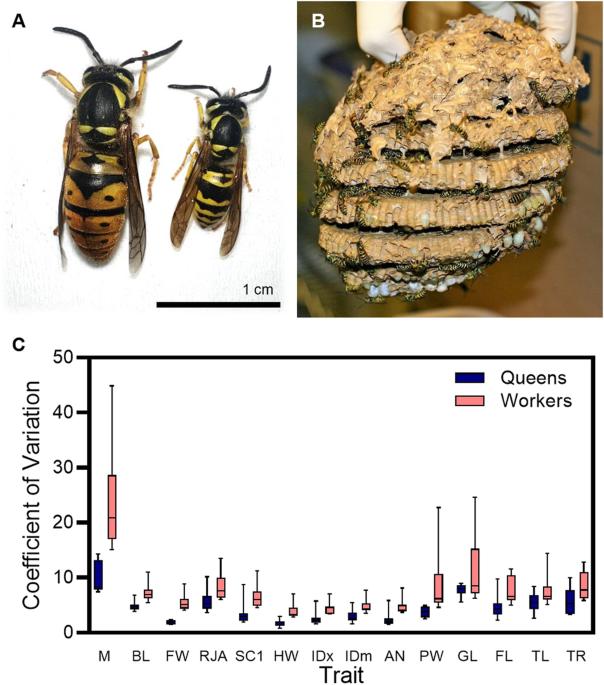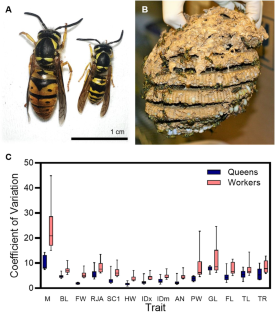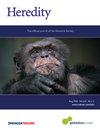Genetic and environmental effects on morphological traits of social phenotypes in wasps
IF 3.1
2区 生物学
Q2 ECOLOGY
引用次数: 0
Abstract
Many species exhibit distinct phenotypic classes, such as sexes in dioecious species or castes in social species. The evolution of these classes is affected by the genetic architecture governing traits shared between phenotypes. However, estimates of the genetic and environmental factors contributing to phenotypic variation in distinct classes have rarely been examined. We studied the genetic architecture underlying morphological traits in phenotypic classes in the social wasp Vespula maculifrons. Our data revealed patriline effects on a few traits, indicating weak genetic influences on caste phenotypic variation. Interestingly, traits exhibited higher heritability in queens than workers. This result suggests that genetic variation has a stronger influence on trait variation in the queen caste than the worker caste, which is unexpected because queens typically experience direct selection. Moreover, estimates of heritability for traits were correlated between the castes, indicating that variability in trait size was governed by similar genetic architecture in the two castes. However, we failed to find evidence for a significant relationship between caste dimorphism and caste correlation, as would be expected if trait evolution was constrained by intralocus genetic conflict. Our analyses also uncovered variation in the allometric relationships for traits. These analyses suggested that worker traits were proportionally smaller than queen traits for most traits examined. Overall, our data provide evidence for a strong environmental and moderate genetic basis of trait variation among castes. Moreover, our results suggest that selection previously operated on caste phenotype in this species, and phenotypic variation is now governed primarily by environmental differences.


遗传和环境对黄蜂社会表型形态特征的影响。
许多物种表现出不同的表型类别,如雌雄异体物种中的性别或社会物种中的种姓。这些类别的进化受到表型之间共有性状的遗传结构的影响。然而,对导致不同类别表型变异的遗传和环境因素的估计却很少进行研究。我们研究了社会黄蜂Vespula maculifrons表型类别中形态特征的遗传结构。我们的数据揭示了父系对少数性状的影响,表明遗传对种姓表型变异的影响较弱。有趣的是,雌蜂的性状遗传率高于工蜂。这一结果表明,遗传变异对蚁后性状变异的影响比对工蚁性状变异的影响更大,这出乎我们的意料,因为蚁后通常会经历直接选择。此外,两个种群之间性状遗传率的估计值是相关的,这表明性状大小的变异受两个种群中相似遗传结构的支配。然而,我们未能发现种性二态性与种性相关性之间存在显著关系的证据,而如果性状进化受到聚焦内遗传冲突的限制,则会出现这种情况。我们的分析还发现了性状异速关系的变化。这些分析表明,在所研究的大多数性状中,工蜂的性状在比例上小于蜂后的性状。总之,我们的数据为种群间性状变异提供了强有力的环境基础和适度的遗传基础。此外,我们的研究结果表明,在该物种中,种姓表型曾受到选择作用,而表型变异现在主要受环境差异的影响。
本文章由计算机程序翻译,如有差异,请以英文原文为准。
求助全文
约1分钟内获得全文
求助全文
来源期刊

Heredity
生物-进化生物学
CiteScore
7.50
自引率
2.60%
发文量
84
审稿时长
4-8 weeks
期刊介绍:
Heredity is the official journal of the Genetics Society. It covers a broad range of topics within the field of genetics and therefore papers must address conceptual or applied issues of interest to the journal''s wide readership
 求助内容:
求助内容: 应助结果提醒方式:
应助结果提醒方式:


